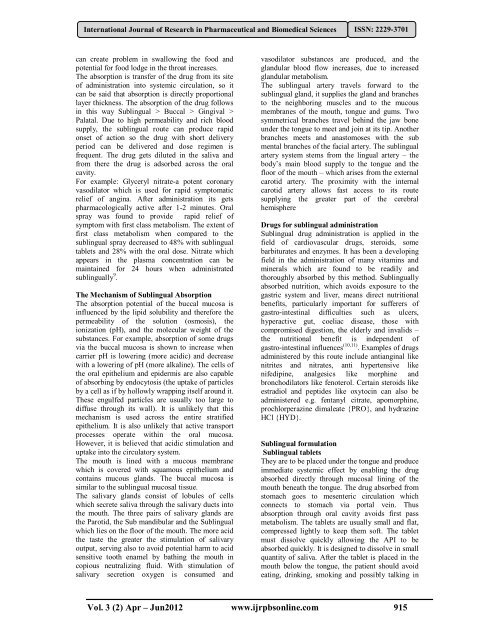An Overview on: Sublingual Route for Systemic Drug Delivery
An Overview on: Sublingual Route for Systemic Drug Delivery
An Overview on: Sublingual Route for Systemic Drug Delivery
You also want an ePaper? Increase the reach of your titles
YUMPU automatically turns print PDFs into web optimized ePapers that Google loves.
Internati<strong>on</strong>al Journal of Research in Pharmaceutical and Biomedical Sciences ISSN: 2229-3701can create problem in swallowing the food andpotential <strong>for</strong> food lodge in the throat increases.The absorpti<strong>on</strong> is transfer of the drug from its siteof administrati<strong>on</strong> into systemic circulati<strong>on</strong>, so itcan be said that absorpti<strong>on</strong> is directly proporti<strong>on</strong>allayer thickness. The absorpti<strong>on</strong> of the drug followsin this way <strong>Sublingual</strong> > Buccal > Gingival >Palatal. Due to high permeability and rich bloodsupply, the sublingual route can produce rapid<strong>on</strong>set of acti<strong>on</strong> so the drug with short deliveryperiod can be delivered and dose regimen isfrequent. The drug gets diluted in the saliva andfrom there the drug is adsorbed across the oralcavity.For example: Glyceryl nitrate-a potent cor<strong>on</strong>aryvasodilator which is used <strong>for</strong> rapid symptomaticrelief of angina. After administrati<strong>on</strong> its getspharmacologically active after 1-2 minutes. Oralspray was found to provide rapid relief ofsymptom with first class metabolism. The extent offirst class metabolism when compared to thesublingual spray decreased to 48% with sublingualtablets and 28% with the oral dose. Nitrate whichappears in the plasma c<strong>on</strong>centrati<strong>on</strong> can bemaintained <strong>for</strong> 24 hours when administratedsublingually 9 .The Mechanism of <strong>Sublingual</strong> Absorpti<strong>on</strong>The absorpti<strong>on</strong> potential of the buccal mucosa isinfluenced by the lipid solubility and there<strong>for</strong>e thepermeability of the soluti<strong>on</strong> (osmosis), thei<strong>on</strong>izati<strong>on</strong> (pH), and the molecular weight of thesubstances. For example, absorpti<strong>on</strong> of some drugsvia the buccal mucosa is shown to increase whencarrier pH is lowering (more acidic) and decreasewith a lowering of pH (more alkaline). The cells ofthe oral epithelium and epidermis are also capableof absorbing by endocytosis (the uptake of particlesby a cell as if by hollowly wrapping itself around it.These engulfed particles are usually too large todiffuse through its wall). It is unlikely that thismechanism is used across the entire stratifiedepithelium. It is also unlikely that active transportprocesses operate within the oral mucosa.However, it is believed that acidic stimulati<strong>on</strong> anduptake into the circulatory system.The mouth is lined with a mucous membranewhich is covered with squamous epithelium andc<strong>on</strong>tains mucous glands. The buccal mucosa issimilar to the sublingual mucosal tissue.The salivary glands c<strong>on</strong>sist of lobules of cellswhich secrete saliva through the salivary ducts intothe mouth. The three pairs of salivary glands arethe Parotid, the Sub mandibular and the <strong>Sublingual</strong>which lies <strong>on</strong> the floor of the mouth. The more acidthe taste the greater the stimulati<strong>on</strong> of salivaryoutput, serving also to avoid potential harm to acidsensitive tooth enamel by bathing the mouth incopious neutralizing fluid. With stimulati<strong>on</strong> ofsalivary secreti<strong>on</strong> oxygen is c<strong>on</strong>sumed andvasodilator substances are produced, and theglandular blood flow increases, due to increasedglandular metabolism.The sublingual artery travels <strong>for</strong>ward to thesublingual gland, it supplies the gland and branchesto the neighboring muscles and to the mucousmembranes of the mouth, t<strong>on</strong>gue and gums. Twosymmetrical branches travel behind the jaw b<strong>on</strong>eunder the t<strong>on</strong>gue to meet and join at its tip. <str<strong>on</strong>g>An</str<strong>on</strong>g>otherbranches meets and anastomoses with the submental branches of the facial artery. The sublingualartery system stems from the lingual artery – thebody’s main blood supply to the t<strong>on</strong>gue and thefloor of the mouth – which arises from the externalcarotid artery. The proximity with the internalcarotid artery allows fast access to its routesupplying the greater part of the cerebralhemisphere<strong>Drug</strong>s <strong>for</strong> sublingual administrati<strong>on</strong><strong>Sublingual</strong> drug administrati<strong>on</strong> is applied in thefield of cardiovascular drugs, steroids, somebarbiturates and enzymes. It has been a developingfield in the administrati<strong>on</strong> of many vitamins andminerals which are found to be readily andthoroughly absorbed by this method. <strong>Sublingual</strong>lyabsorbed nutriti<strong>on</strong>, which avoids exposure to thegastric system and liver, means direct nutriti<strong>on</strong>albenefits, particularly important <strong>for</strong> sufferers ofgastro‐intestinal difficulties such as ulcers,hyperactive gut, coeliac disease, those withcompromised digesti<strong>on</strong>, the elderly and invalids –the nutriti<strong>on</strong>al benefit is independent ofgastro‐intestinal influences (10,11) . Examples of drugsadministered by this route include antianginal likenitrites and nitrates, anti hypertensive likenifedipine, analgesics like morphine andbr<strong>on</strong>chodilators like fenoterol. Certain steroids likeestradiol and peptides like oxytocin can also beadministered e.g. fentanyl citrate, apomorphine,prochlorperazine dimaleate {PRO}, and hydrazineHCl {HYD}.<strong>Sublingual</strong> <strong>for</strong>mulati<strong>on</strong><strong>Sublingual</strong> tabletsThey are to be placed under the t<strong>on</strong>gue and produceimmediate systemic effect by enabling the drugabsorbed directly through mucosal lining of themouth beneath the t<strong>on</strong>gue. The drug absorbed fromstomach goes to mesenteric circulati<strong>on</strong> whichc<strong>on</strong>nects to stomach via portal vein. Thusabsorpti<strong>on</strong> through oral cavity avoids first passmetabolism. The tablets are usually small and flat,compressed lightly to keep them soft. The tabletmust dissolve quickly allowing the API to beabsorbed quickly. It is designed to dissolve in smallquantity of saliva. After the tablet is placed in themouth below the t<strong>on</strong>gue, the patient should avoideating, drinking, smoking and possibly talking inVol. 3 (2) Apr – Jun2012 www.ijrpbs<strong>on</strong>line.com 915
















